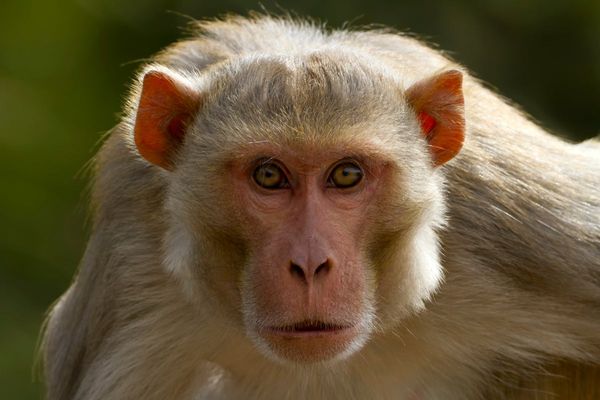
The Vile clings on to the edge of the Gower peninsula. Its fields are lined up like strips of carpet, together leading to the edge of the cliff that drops into the sea. Each one is tiny, around 1-2 acres. From the sky, they look like airport runways, although this comparison would have seemed nonsensical to those who tended them for most of their existence.
That is because the Vile is special: a working example of how much of Britain would have been farmed during the middle ages. Farmers have most likely been trying to tame this promontory since before the Norman conquest.
The fields have retained their old names, speaking to a long history of struggle against the soil. Stoneyland. Sandyland. Bramble Bush. Mounds of soil known as “baulks” separate one strip from the next. During the summer months, linseed and sweet clover paint the landscape with stripes of bright yellow and cotton-blue, recreating a scene that had occurred here for many of the last thousand summers. On the edge of the promontory were the hay meadows, almost ready to burst with pollen and petals.
The Vile is a rare example of the open-field system: a method of communal agriculture once practised across Europe. Under this system, each farmer attended his own strip of land, with the members of the village coming together more widely to cooperate and plan a healthy harvest. Remnants of such farms survive as shadows and undulations across the countryside today, showing the paths of ox-drawn ploughs as they moved up and down the fields, pushing the soil to the side as they went.
Farming is often seen as inimical to biodiversity, but these thin strips of land tell a more complex story. In the nooks and crannies of medieval farms, like the Vile, a wide range of plants and animals would have found the conditions they needed to survive. Ground-nesting birds could find cover and camouflage in the fields left fallow – something that was done every few years to allow the soil to recover. Baulks offered safe passage to small mammals as they navigated the cultivated land. The naturalist Colin Tubbs, in a survey of Hampshire, found that only a third of the county’s birds were adapted to woodland, with the rest preferring open, marsh, coastal or riverine habitats. Farmers “inherited the flora and fauna of the more ancient habitats, and indeed, in modifying the landscapes from which they derived, they may have increased plant and animal diversity,” he wrote.
The road that leads to the cliffs is narrow, bounded by stone walls and hedgerows. It would not easily admit the kind of heavy machinery that has pounded the rest of the countryside into submission. Even so, the Vile did not emerge completely unscathed from Britain’s postwar drive for agricultural efficiency. Certain strips were amalgamated into larger fields, baulks flattened to make way for more crops and larger equipment. When the National Trust bought the land in 1970, it was well on the way to looking like a modern farm. For years after that, a dual system remained in place: some tenants worked to extract the maximum yield from the expanded fields while others kept their medieval strips. Around 2013, however, those tenancies started to come to an end, and an unusual experiment got under way. The Trust decided to restore the Vile to how it would have looked during medieval times.
Volunteers rebuilt the baulks, removed the contaminated topsoil and reseeded the earth, creating the conditions for flora and fauna to flourish once again. Farming continued but with renewed purpose: the yield they were pursuing this time was not crops but nature. Wildlife returned quickly to the peninsula. Weasels darted across the paths and whitethroats sang from the thistles. Hen harriers returned to hunt in the fields left fallow and the predatory larvae of oil beetles lay in wait for bees upon the flowers. Common fumitory and mustard sprang up from the disturbed soils. In the meadows, knapweed, speedwell and eyebright bloom. “It doesn’t take much to reverse things from where we are,” said Mark Hipkin, a National Trust ranger.
Today, agriculture has reached an industrial level and almost all of Britain’s hay meadows have vanished. Modern livestock are fattened on ryegrass that has been pickled into silage. Ryegrass grows thickly, smothering most other species, and matures quickly, allowing farmers to take a cut before any survivors have set seed. This has led to widespread botanical decline. With the average farmer no longer relying on hay to see their animals through the winter, the care of the meadows that remain has fallen to ecologically minded throwbacks, farmers collecting special subsidies or conservation charities such as the National Trust.
The Vile is an interesting experiment, but no one – not even the National Trust – claims that the revival of medieval agriculture can feed the world. There are tens of millions more mouths to feed now than during the middle ages. That doesn’t mean that there are no lessons to be learned from these strange weather-beaten strips.
By taking on the role of megafauna and preventing the domination of closed-canopy forest, early farmers carved out space for open-land species that would otherwise have been lost to the darkness. Though obviously not a perfect replica of the prehistoric ecosystems, small-scale farming recreates something of the disturbance and complexity that would have enabled so many species to thrive before the advent of agriculture. Human-created landscapes need not be the enemy of nature, not even when they are also producing food. By reintroducing some of that old diversity into the modern farmed landscape, some of the riotousness of those medieval fields may too be restored.
However, as a model for the wider restoration of small-scale farming, the greatest drawback of the Vile is that it is essentially a nature conservation project. The land is not farmed to produce calories or turn a profit, but to support declining wildlife. Half the crop is left standing as food for the birds.
This is in stark contrast to the function of such farms in centuries past, when productivity was a question of life or death. Nature was just the byproduct of the need to produce food. During the 1700s, for instance, there were meadows in Islington, Paddington and St Pancras. These existed to fulfil an agricultural purpose, not because the residents of the city had a particular fondness for wild flowers. A kind of culture emerged around such fields: agricultural handbooks from the time show that football games and bull-baiting events were organised to destroy moss, drive away moles and trample seeds into the soil.
It is this kind of practical entanglement with the land that can produce some of the greatest returns for nature. Studies suggest that hay meadows managed for nature are ultimately poorer in species than those tended to produce winter fodder. This is because the decisions of a hundred individual farmers, tailored to the precise conditions of their land – soil, shelter, wind direction, altitude – create more diverse landscapes than a set of centralised rules.
In some cases, payments designed to protect nature have even had the opposite effect. In the stretch of the Carpathians that crosses into the Czech Republic, for instance, the threatened Danube clouded yellow butterfly was wiped out from its stronghold after the introduction of a regimented, twice-a-year mowing regime – an initiative spurred on by the introduction of EU environmental subsidies.
Conservationists may have saved the last of Britain’s meadows. But, as far as nature is concerned, the old ways are often still the best ways.
This is an edited extract from Nature’s Ghosts: The world we lost and how to bring it back, published by HarperNorth







